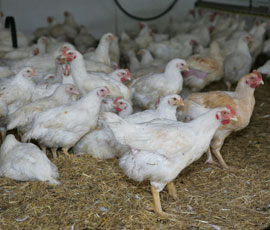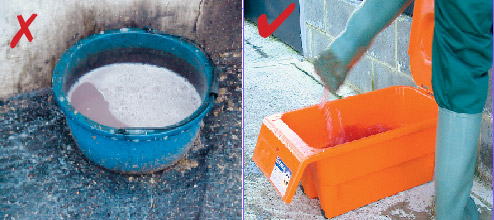Beef up biosecurity to stop enemies at the gate

Biosecurity is a key part in the fight against animal diseases, together with vaccination and good management practice
The ideal biosecurity programme should begin at the entry gate, by regulating the number of visitors. It should then continue at the entry points of each poultry shed, using “barrier methods” such as changing boots, clothing and showering in and out.
For many units, however, defence against disease begins with footbaths (see below) – a visible and reassuring form of protection. Unfortunately, the boot-dipping facilities are often nowhere near as robust as some operators believe, says Geoff Hooper of hygiene company Hysolv.
A well-known supermarket chain commissioned a survey on the use of foot-baths on its supplier farms across the UK. It found that 20% of farms did not have designated entry/exit points where visitor biosecurity could be controlled, and 90% did not have lids on foot-baths to exclude rain or prevent evaporation.
Just 5% of farms surveyed kept records as to when foot-bath contents were changed, and only 10% changed their disinfectant more than twice a week, making most foot-baths in the survey “ineffective for most of the time”.
The survey did, however, have some encouraging news. For instance, 85% of respondents were aware that organic matter reduced disinfectant activity.
“This is a good result because organic matter poses a major threat to disinfectant efficacy and can very quickly degrade the performance of usually potent products,” says Mr Hooper.
Conversely, less than 50% of respondents were aware that lower temperatures adversely affect disinfectant efficacy.
Information is clearly the key to good disinfection choice, and the survey revealed five main sources of information:
- Veterinary surgeon – 25%
- DEFRA’s website – 25%
- A farm representative – 35%
- “Van man” – 5%
- Trade person – 5%
“Specific advice is crucial,” says Mr Hooper. “The right decision can only be made by taking into account the likely levels of organic matter and environmental temperature.
“This survey suggests that, overall, the poultry sector could do better when it comes to mounting an effective first line of defence in the form of biosecurity.”
He recommends the following:
- Monitor and audit your biosecurity
- Change contents regularly (see table 1)
- Use an appropriate disinfectant at the correct concentration (see table 2). Rule of thumb for foot-dips – look at the DEFRA approval data and double it for use in foot-baths
- When temperatures are low, consider using a more suitable product as freezing disables most disinfectants.

| 1. Foot-dips – General replenishment guide | ||
Type of disinfectant | Replenishments per week |
|
| Light soiling | Heavy soiling |
Glutaraldehyde + Formaldehyde | 1 | 2 |
Glutaraldehyde + Quat ammonium salt | 2 | 3 |
Chlorocresol (phenol) | 1 | 2 |
Oxidising disinfectants | 2-4 | 3-7 |
Iodophores | 2 | 3 |
Quat ammonium salts | 2 | 3 |
2: Typical concentration rates for disinfectants | |||||
Type of disinfectant | Concentration of disinfectant required in a footbath to eliminate different microorganisms | ||||
| Non-enveloped viruses | Enveloped viruses | Bacteria | Fungi | Coccidial oocysts Red mite and mite eggs |
Glutaraldehyde + Formaldehyde | 1% | 1% | 1% | 1% | |
Glutaraldehyde + Quat ammonium salt | 0.5-1% | 1-3% | 2-4% | 2 – 6% | |
Chlorocresol (phenol) | 4% | 2% | 0.5% | 2% | 3-4% |
Oxidising disinfectants | 0.2-1% | 0.5-3% | 1-2% | 0.5-5% | |
Iodophores | 2% | 2% | 2% | ||
Quat ammonium salts | Not effective | 1% | 1% | 0.1-0.5% | |
